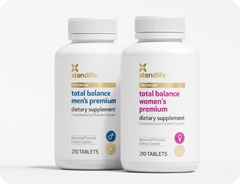In our pursuit of vibrant health, many of us strive for a balanced diet packed with nutrient-rich foods. However, even the most wholesome diet may still leave us lacking in essential nutrients, particularly Omega-3 fatty acids.
Healthy Eating is Only Part of the Solution
Despite our best efforts to nourish our bodies, modern food production and environmental factors often lead to nutrient deficiencies. From mineral-depleted soils to long-distance transportation, various factors can compromise the nutritional content of our food.
Compared to foods grown just 30 years ago, commercially grown vegetables, fruits, and grains contain significantly lower nutritional content.[1]
- Proteins in rice, wheat, and barley have also declined.[2] Wheat has experienced a 23% decline, with notable reductions in manganese, iron, zinc, and magnesium.[3]
- Fruit and vegetables have shown a 52% drop in calcium levels, 49% in copper, and 10% in magnesium.[4]
Additionally, some of us may have dietary restrictions, making it even more challenging to meet our nutritional needs through food alone.
Your Diet May Fall Short on Omega-3
Omega-3 fatty acids are essential for nourishing the body and offer an array of health benefits, including support for brain development, cardiovascular health, and immune function. But unfortunately, it is a particular type of fat the body is unable to create on its own. By prioritizing Omega-3 supplementation, you empower your body with the nutrients it needs to thrive.
However, meeting the recommended intake of omega-3s from food sources alone can be challenging. Here's why:
- Limited Food Sources: Fatty fish, such as salmon, mackerel, and sardines, are among the primary dietary sources of omega-3s. However, not everyone enjoys or has access to these fish regularly, making it difficult to obtain sufficient omega-3s solely from food. Although walnuts, flaxseeds, and chia seeds can provide alpha-linolenic acid (ALA), it requires the body to convert it to DHA and EPA.
- Dietary Preferences: Many individuals may have dietary preferences or restrictions that limit their consumption of omega-3-rich foods.
- Nutrient Depletion: The omega-3 content of food can be affected by processing and cooking methods. Plus, industrial farming practices have led to changes in the nutrient composition of foods, including omega-3 fatty acids.
Why Supplement?
While a balanced diet is essential for overall health, it may not provide sufficient amounts of certain nutrients, such as omega-3 fatty acids. Supplementation can help bridge this nutritional gap and ensure you receive the recommended intake of these essential nutrients.
Embrace a more vital you
Elevate your daily health with Xtendlife's Daily Care Bundle: Multi-Xtra and Omega 3/DHA Fish Oil.
Shop now
How to Introduce Omega-3s into Your Diet
To ensure adequate omega-3 intake, consider incorporating the following strategies:
- Eat Fatty Fish Regularly: Aim to consume fatty fish like salmon, mackerel, or sardines at least twice a week.
- Incorporate Plant-Based Sources: Include foods like walnuts, flaxseeds, and chia seeds in your meals and snacks.
- Consider a High-Quality Omega-3 Supplement: For those who struggle to meet their omega-3 needs through diet alone, a high-quality fish oil supplement can be an effective and convenient solution.
Our superior fish oil supplements provide a concentrated source of DHA and EPA, the two most beneficial omega-3 fatty acids for overall health. Derived from sustainable sources and rigorously tested for purity, it's an excellent way to ensure you're getting enough of these essential nutrients.
References:
- Davis, D. R., M. D. Epp, and H. D. Riordan. 2004. Changes in USDA food composition data for 43 garden crops, 1950 to 1999. Journal of the American College of Nutrition 23(6):669–682.
- Medek DE, Schwartz J, Myers SS. Estimated Effects of Future Atmospheric CO2 Concentrations on Protein Intake and the Risk of Protein Deficiency by Country and Region. Environ Health Perspect. 2017;125(8):087002. Published 2017 Aug 2. doi:10.1289/EHP41
- Mariem, S.B., Gámez, A.L., Larraya, L. et al. Assessing the evolution of wheat grain traits during the last 166 years using archived samples. Sci Rep 10, 21828 (2020). https://doi.org/10.1038/s41598-020-78504-x
- Anne-Marie Berenice Mayer, Liz Trenchard & Francis Rayns (2022) Historical changes in the mineral content of fruit and vegetables in the UK from 1940 to 2019: a concern for human nutrition and agriculture, International Journal of Food Sciences and Nutrition, 73:3, 315-326, DOI: 10.1080/09637486.2021.1981831


 Supplements
Supplements Skincare
Skincare Superfoods
Superfoods Bundles
Bundles
















